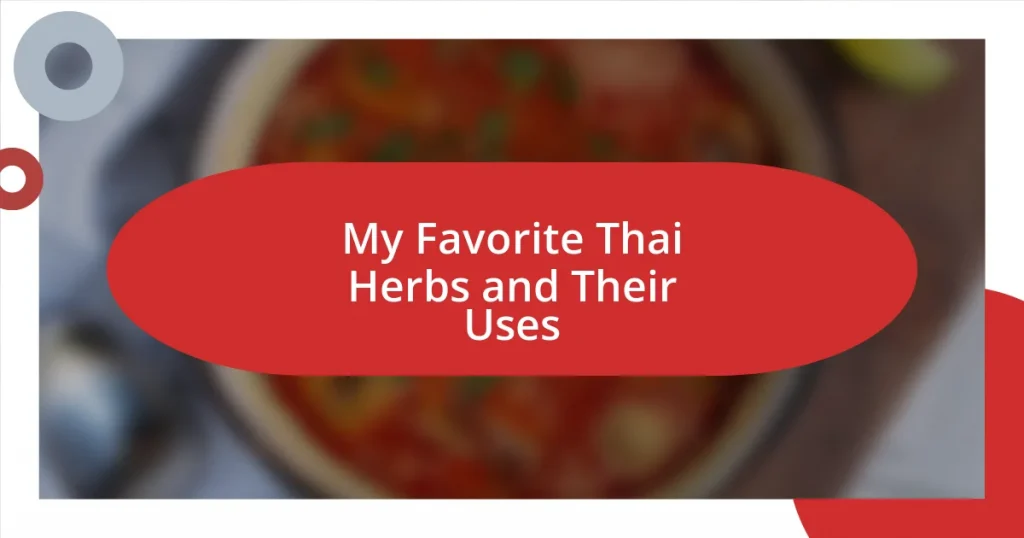Key takeaways:
- Thai herbs are fundamental to Thai cuisine, offering rich flavors and cultural significance, with personal anecdotes illustrating their transformative impact on dishes.
- Key medicinal benefits of Thai herbs include anti-inflammatory properties from turmeric, respiratory support from Holy Basil, and digestive aid from ginger and lemongrass.
- Freshness is crucial in cooking with Thai herbs; proper storage techniques and using herbs at peak freshness greatly enhance flavor and culinary experiences.
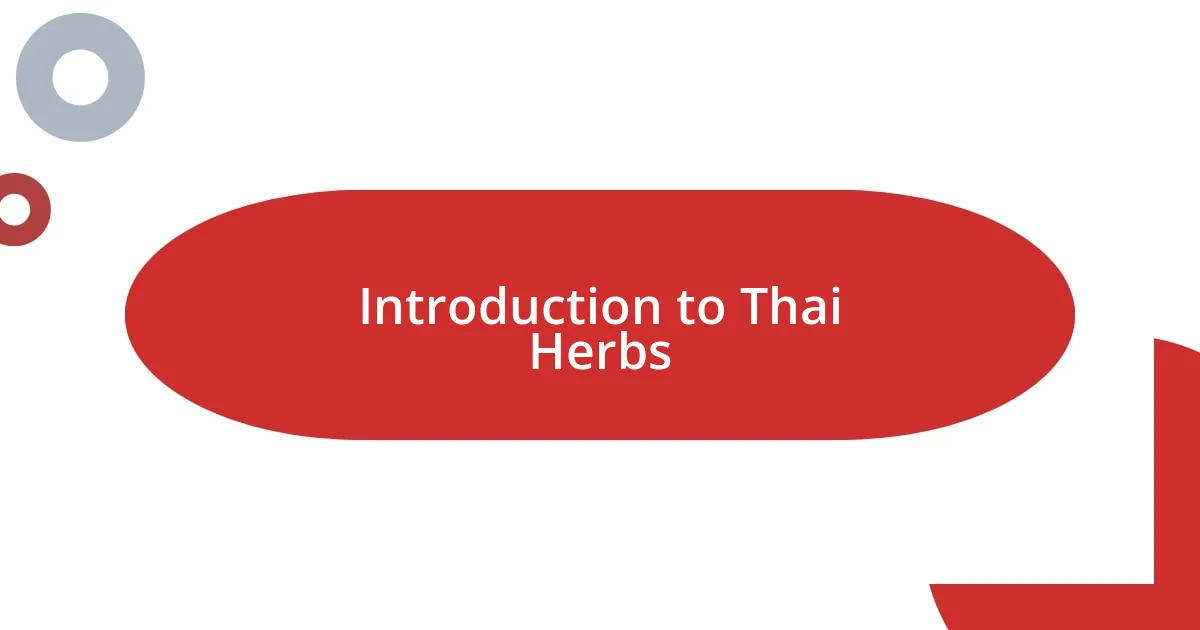
Introduction to Thai Herbs
Thai herbs are not just ingredients; they are the essence of Thai cuisine, woven deeply into the culture and daily life of the people. I remember my first cooking class in Thailand, where each herb was introduced with such reverence. It felt like each plant had its own story, its own magic.
When I first encountered Thai basil, I was struck by its vibrant aroma and flavor. It wasn’t just an herb but a bridge to the rich tapestry of Thai dishes. Have you ever felt that an ingredient can take you back to a specific moment? For me, the scent of lemongrass still reminds me of sun-soaked afternoons spent exploring local markets.
As I started experimenting with these herbs in my own kitchen, I discovered how they could transform simple meals into flavorful experiences. Isn’t it fascinating how something as small as a leaf can elevate a dish? This journey has made me realize that Thai herbs are indeed a treasure trove of flavors and traditions waiting to be explored.
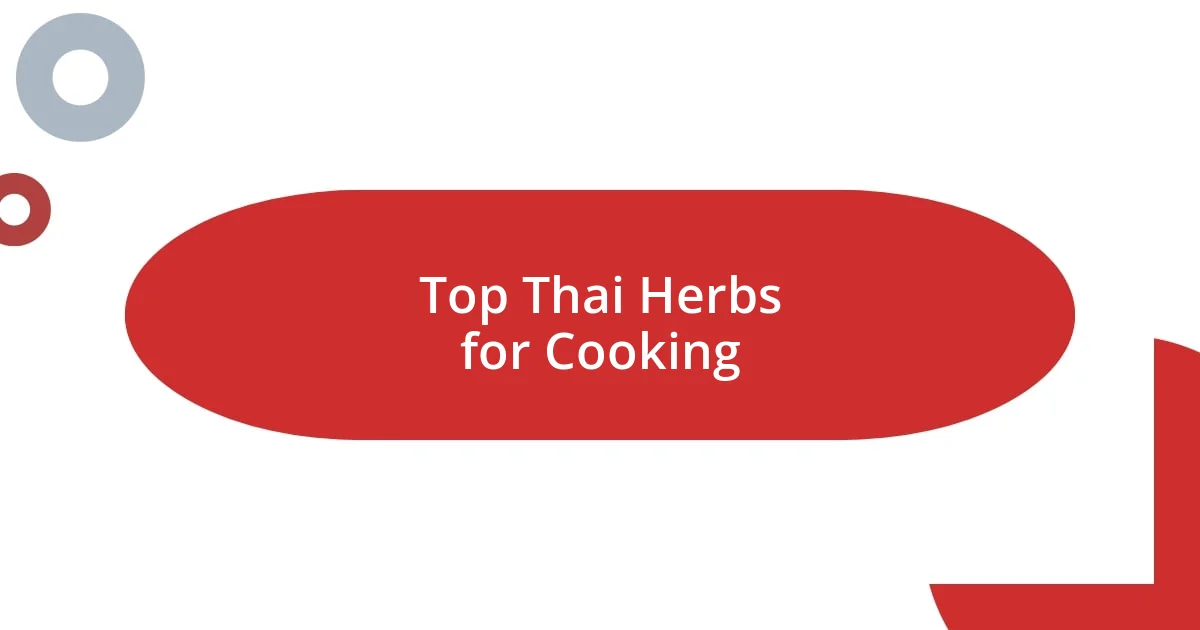
Top Thai Herbs for Cooking
Thai cooking is a vibrant symphony of flavors, and the herbs are the musicians that bring everything together. Take cilantro, for example. I recall a family dinner when I sprinkled fresh cilantro over a bowl of spicy soup, and suddenly, all the flavors danced in perfect harmony. It has that refreshing zest that brightens dishes, and its versatility can’t be understated—whether it’s in salsas, salads, or garnishes, it adds a unique flair.
Another standout is galangal, often confused with ginger. The first time I sliced into galangal, its fiery, citrusy notes astounded me. I added it to a curry, and it instantly elevated the dish. It has a more complex flavor profile than ginger, which makes it a thrilling addition. If you haven’t experimented with galangal, I genuinely encourage you to give it a try—just be ready for a delightful explosion of aromas.
Then there’s lemongrass, which I hold in special regard for its ability to infuse dishes with a refreshing flavor that’s unmistakable. I remember visiting a local market in Thailand, where the vendor handed me a bunch of fresh lemongrass to smell. The fragrance was like a breath of fresh air. I often use lemongrass in marinades, and it works wonders in stews. It’s incredible how each herb tells its own story through the dishes it enhances.
| Herb | Flavor Profile |
|---|---|
| Cilantro | Fresh, citrusy, and slightly peppery |
| Galangal | Fiery, earthy, with hints of citrus |
| Lemongrass | Bright, citrusy, and refreshing |

Medicinal Benefits of Thai Herbs
Thai herbs offer a multitude of medicinal benefits that have been celebrated for centuries. I recall a quiet afternoon in Thailand when my guide shared how turmeric, a staple in many Thai dishes, is revered not just for its flavor but for its health-boosting properties. Its vibrant yellow hue comes from curcumin, known for its anti-inflammatory and antioxidant effects. Using it regularly in cooking has sparked my curiosity about holistic health, encouraging me to explore other herbs that support well-being.
Here are some key medicinal benefits of Thai herbs:
- Turmeric: Reduces inflammation, helps in digestion, and boosts immune function.
- Holy Basil (Bai Horapha): Known for its stress-relieving properties and ability to support respiratory health.
- Ginger: Aids in digestion, alleviates nausea, and has anti-inflammatory effects.
- Lemongrass: Promotes digestion and may help lower cholesterol levels.
- Coriander (Cilantro): Contains antioxidants and may help reduce blood sugar levels.
Each herb has its own role in not just flavoring dishes but also contributing to a healthier lifestyle. For me, adding these herbs to my meals feels like infusing my cooking with a bit of nature’s best medicine. The idea that something so simple could potentially benefit my health is quite empowering.
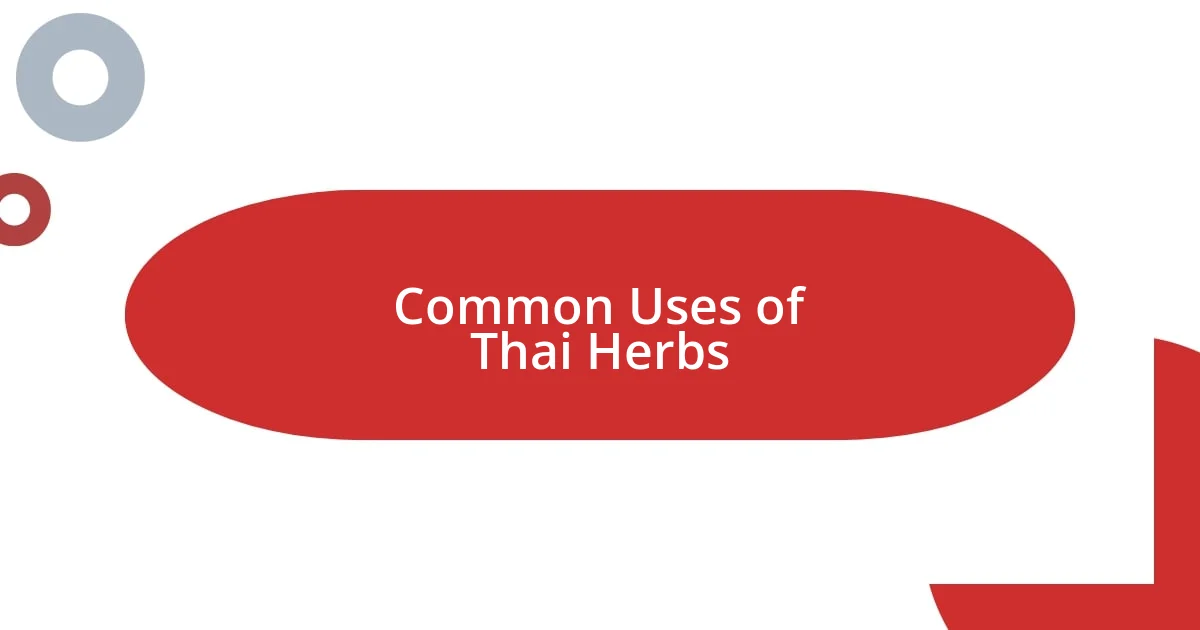
Common Uses of Thai Herbs
Thai herbs are not just essential for flavor; they are integral to many culinary routines in Thai households. I remember watching my friend prepare a traditional Tom Yum soup, where she tossed in fistfuls of fresh Thai basil. The aroma that filled the kitchen was intoxicating, creating an atmosphere that beckoned everyone to gather around. It’s remarkable how a handful of basil can turn a simple broth into an aromatic delight that tantalizes the senses.
Using these herbs extends beyond cooking to preserving cultural traditions. For instance, I attended a festival in Thailand where vendors showcased dishes made with various herbs. One vendor’s use of pandan leaves to wrap sticky rice made the dish not only tasty but also visually stunning, presenting a feast for the eyes. I think it’s fascinating how these herbs serve as a bridge between culinary art and Thai heritage, maintaining the flavors and methods passed down through generations.
Furthermore, the versatility of Thai herbs allows them to shine in both savory and sweet dishes. I once experimented by adding basil to a fruit salad, and the unexpected pairing burst with freshness. Have you ever thought about pushing the boundaries with herbs? It’s thrilling to realize how these ingredients can cross culinary borders, offering endless possibilities for creativity in the kitchen. Each herb tells a story, and it is within those stories that we discover vibrant and enriching culinary experiences.

Growing Thai Herbs at Home
Growing Thai herbs at home is an incredibly rewarding endeavor. I remember the first time I planted Thai basil in a small pot on my balcony. Watching it sprout and flourish under my care felt like a personal achievement. There’s something wonderful about stepping out into my little herb garden, filled with the fragrant aroma of fresh herbs that brightens my cooking experiences.
When it comes to growing these herbs, I’ve found that they thrive in well-drained soil and plenty of sunlight. I’ve learned that watering them consistently, but not overwatering, is crucial. The day I picked my first handful of lemongrass for a stir-fry was a delightful moment. Have you ever tasted a dish with herbs you’ve grown yourself? The flavor is unmatched; it’s as if the love and care infuse right into each bite.
I often encourage friends to join me in this green adventure. It’s a joy to share the experience of nurturing something from seed to supper. I remember a weekend when my friend and I turned our planting session into a mini-harvest party, laughing as we snipped fresh cilantro and reminisced about our favorite Thai dishes. The connections we create through food and gardening truly enrich our lives, don’t you think?
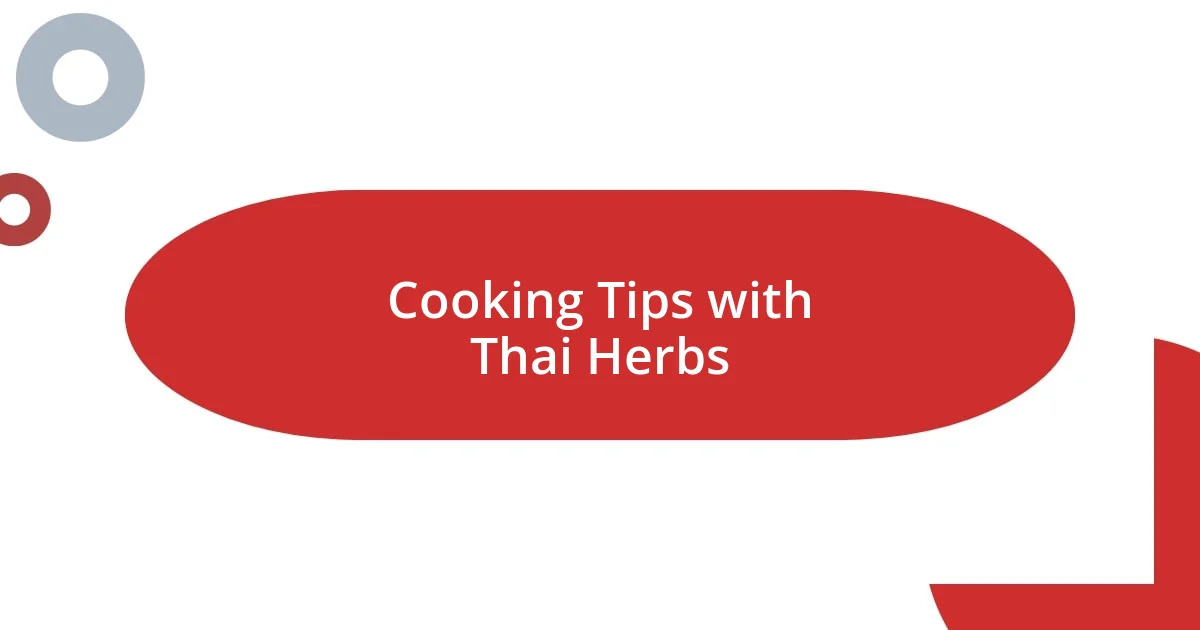
Cooking Tips with Thai Herbs
When cooking with Thai herbs, I’ve discovered that fresh is always best. I recall a memorable evening when I decided to whip up a homemade Pad Thai. Instead of reaching for dried herbs, I grabbed a bunch of fresh cilantro and Thai chili. The instant pop of brightness those ingredients brought to the dish was remarkable. Have you ever felt the difference that fresh herbs make to a meal? It’s as if they breathe life into the food, creating a vibrant experience that frozen or dried simply can’t replicate.
Another handy tip is to chop herbs just before you plan to use them. I remember my first time preparing green curry; I made the mistake of chopping basil too early. By the time I added it to the dish, most of its amazing aroma had dissipated. Now, I make it a habit to wait until I’m ready to cook. Timing, it turns out, is everything when it comes to maximizing flavor!
In my experience, balancing flavors is key when using Thai herbs. I often find myself experimenting with combinations. Once, I paired mint and lime in a fish dish, hoping to elevate the freshness. The result? A light, zesty explosion that reminded me of a sun-soaked afternoon in Thailand. What’s your favorite herb combination? The beauty of cooking with Thai herbs is that there’s no wrong answer—just an opportunity to explore and find flavors that resonate with you.
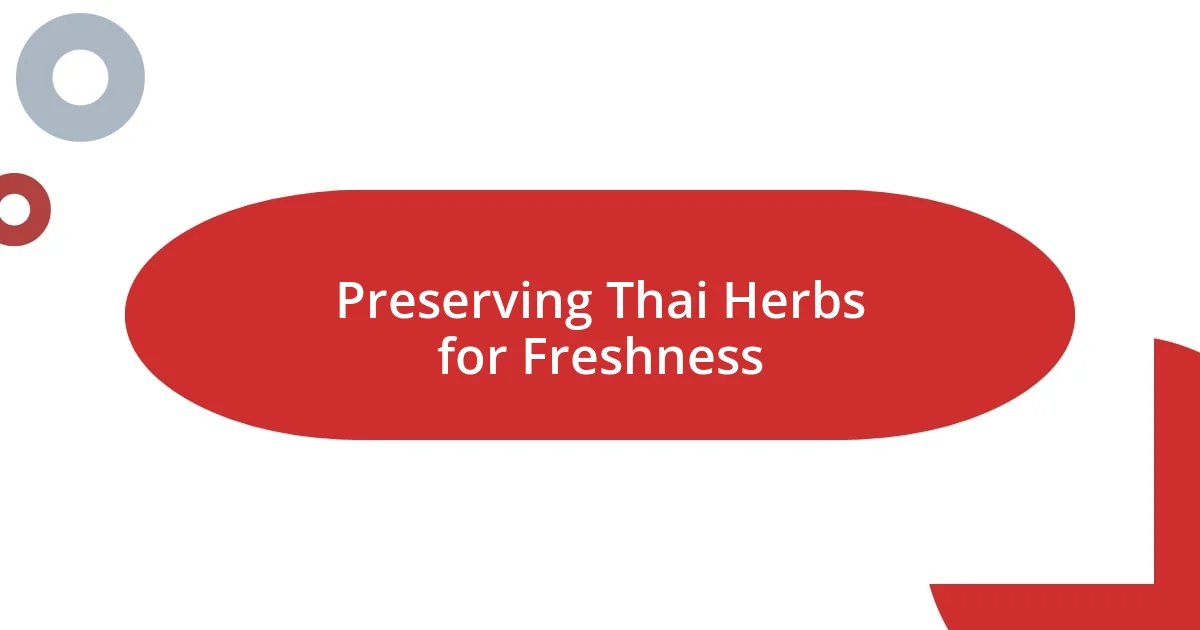
Preserving Thai Herbs for Freshness
To keep Thai herbs as fresh as possible, I’ve discovered a few methods that make all the difference. After gathering a bountiful harvest of coriander one sunny afternoon, I quickly learned that wrapping them in a damp paper towel and placing them in a perforated plastic bag works wonders. It’s like giving them a little spa treatment, allowing them to stay vibrant while I plan my next culinary adventure. Have you ever experienced the thrill of reaching for fresh herbs, only to find them wilting? It’s heartbreaking, but with this simple trick, you can avoid that disappointment!
I also love to make herb ice cubes, a method I stumbled upon during a busy week when I had surplus Thai basil. Blending fresh herbs with a splash of olive oil and freezing them in an ice cube tray gave me an instant flavor boost for my future stir-fries and soups. Each time I pop one into a bubbling pot, I can’t help but smile, knowing I’ve captured summer’s essence in a little cube of delight. It’s a practical solution that truly brings the garden back to life, even in the depths of winter.
Lastly, I often remind myself not to overlook the importance of proper storage. Putting herbs upright in a glass of water, like a lovely floral arrangement, has transformed my kitchen into a fresh-herb wonderland. I once hosted a Thai-inspired dinner party and had a beautiful display of lemongrass and mint on the counter. The vibrant colors and invigorating scents captivated my guests, sparking conversations about our favorite herb uses. How do you store your herbs? It’s all about finding those small practices that keep them fresh and lively, enriching our culinary experiences.










